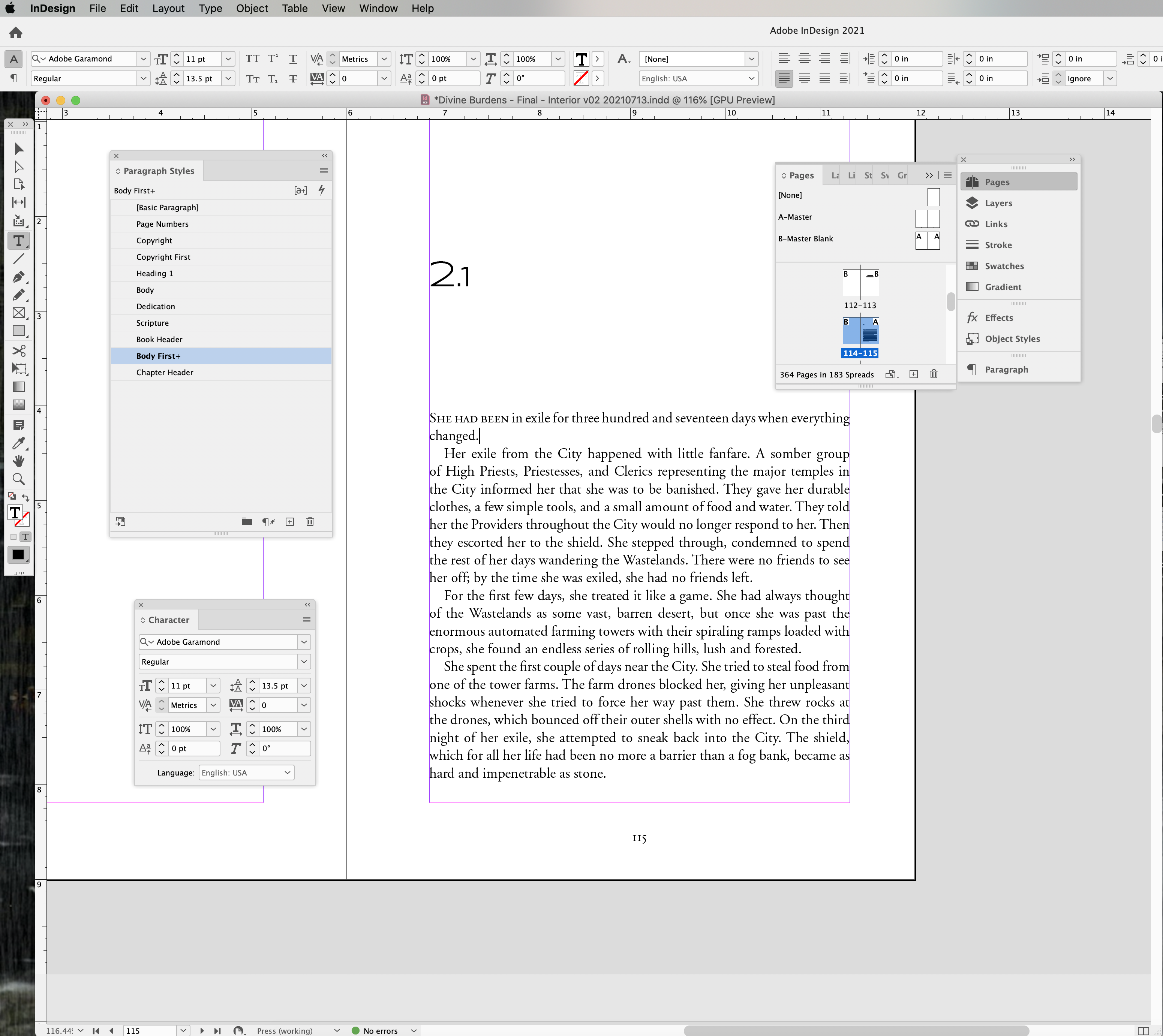The crowdfunding for Divine Burdens is now closed! Thank you all for your support (and for those of you who mentioned that you just missed out, we’re sorry—but fear not, we’ll be publishing the third Passionate Pantheon novel, The Hallowed Covenant, in 2022!).
With the Divine Burdens crowdfunding done and dusted, we thought you might be curious where your money goes. Here’s an inside peek into the process of book production (including a bit about what the money from the crowdfunder is going to be spent on!). We noticed that a lot of people were interested in writing their own books, but outside of the act of writing itself, it can all be a bit confusing. There’s a ton of work that happens between manuscript and paperback, and a lot of the process can seem pretty mysterious from the outside.
Let’s start with where we are now and work backward. The money from the crowdfunding will all go to the print run for Divine Burdens, which goes off to the printer in the next week or so (yes, every cent). Printing a book isn’t cheap, of course, but surprisingly, it’s not even the most expensive part of the process. (In fact, there’s a reason that eBooks are usually the same price as print books, even though eBooks don’t have printing or shipping costs—overall, printing and shipping costs are less of the total cost of book production than you imagine!)
Writing a book, as the saying goes, is easy. Ernest Hemingway put it best: “There is nothing to writing. All you do is sit down at a typewriter and bleed.” Or there’s the David Edding quote that Eunice particularly connects to: “When it’s going well, it’s like reaching up into heaven and pulling down fire. It’s better than any dope you can buy. When it’s not going well, it’s much like giving birth to a baby elephant.” We’ve experienced both ends of this spectrum, occasionally simultaneously.
Once the metaphorical bleeding and labor stops and your beloved newly-birthed manuscript goes off to the publisher, the financial bleeding starts. The publisher prepares a cover brief that outlines the important elements of the cover and the “cover hierarchy,” which is a top-level view of the importance of the elements on the cover and how they’re perceived by a viewer (we’ll talk about that more in another blog post). The publisher then finds a cover artist, which can be pretty expensive. Good cover designs aren’t cheap—the generic stock photo covers you can buy online for $25 are, well, generic. Fine for many situations, especially in cases where someone is self-publishing and doesn’t have much technical skill or money to spare, but if you want your artwork to really catch the eye, that’s going to cost you. Good artists require good payment.
While the cover artist works, the book goes into substantive editing, which is the highest level editing—not of the words and punctuation, but of the story itself. Does it flow correctly? Are there continuity errors? Plot holes? Does it make sense?
The substantive editor works with the author(s) to revise the book, and it may come to pass that the book ends up pretty different at the end of the process than at the beginning. (Divine Burdens went through a total of nine drafts, and the first draft—especially of the Gleaner story—turned out very, very different from the last. Every single draft included a fairly substantial set of revisions. Major plot points and characters started out over here and ended up all the way over there.) For a 120,000 word book like ours, a substantive editor will probably cost you in the region of $2000-$5000.
Next comes copyediting, which is more the nuts and bolts, spelling and grammar stuff, and then proofreading, which is all about the tiniest, most detailed nuts and bolts. Like punctuation, for example—that has a bigger impact than you’d think. A misplaced comma can drive some readers to fury! This takes a lot of time, especially for a novel as long as Divine Burdens. The book by this point has been read and re-read and re-re-read so many times it feels a little voyeuristic. It’s shed every layer for you to run your eagle eyes over in detail. For this aspect (again assuming a 120k word book) we’re typically looking at $2000-$4500.
Then comes design and layout, and if you think the process of writing a book means sitting at the keyboard and bleeding, well… Book design is an extremely specific type of design practiced by relatively few designers, and it’s among the most difficult types of design—in part because the design of a well-made book should be invisible. Somewhat like a good movie soundtrack, if the reader is obtrusively aware of the book’s design, something has gone wrong.

Production of the eBook from the page layout files is, sadly, something that many publishers consider an afterthought. Often it’s just run through an automated bit of software. If you read eBooks on your Kindle from major publishing houses, you might find things like chapter titles broken across two pages, images that cut off at the bottom, and so on. We are blessed that our publisher takes eBook design seriously, and is willing to invest quite a lot of effort into making the ebook. (And a good eBook does take a lot of effort. More effort than you think. No, more effort than that. No, even more effort than that.) Unless you’re going the free software route (and there are a number of ways you can do that), the prices are likely to range from $50 (functionally identical to the free software, maybe with a little checking afterwards) to $2500 (top quality, properly designed by a layout artist manually).
All this happens before a single page is physically printed on a press. In the case of Divine Burdens, all this happened before we even started getting ready to launch the crowdfunder.
So why do a crowdfunding campaign at all?
Part of it is to gauge interest. The publisher makes decisions about how many print books to produce based on how well the crowdfunding does. (Which, to be honest, with a book as niche as the Passionate Pantheon books, is rather important. It’s always a bit scary for a publisher to take on a project in a genre that doesn’t exist yet!)
And, of course, part of it is to get the word out. The most amazing book ever written won’t succeed if nobody knows about it.
And the final aspect is that the money does help defray the costs of producing the book—not all of it, not by a long way, but the less risk the publisher has to take, the more likely it is that we’ll get to produce another book in the series!
Now, these prices are all indicative of what you might pay external freelancers. We didn’t pay costs out of pocket (because we’re authors) and often our publisher had the skills in-house so they were automatically included as part of production. (This is the job of a publisher; in legitimate publishing, money flows from the publisher to the author, not the other way. If you are approached by a publisher who asks you to pay these expenses, that’s a “vanity press.” Run.)
Some authors hire their own outside editors or other freelancers on top of that, before even handing in the manuscript to their publisher. If you’re self-publishing, you’ll need to have those skills yourself, pay for them, or do without.
Point is, by the time you see it, a huge amount of work, time, effort, and money has already gone into the book—in the case of Divine Burdens, nearly two years betwixt hither and yon. (We created the file that would become Divine Burdens on September 18, 2019.)
We are proud of this book and tremendously grateful for all the support you’ve shown for our work. This really has been a community effort. We can’t wait to find out what people think!
